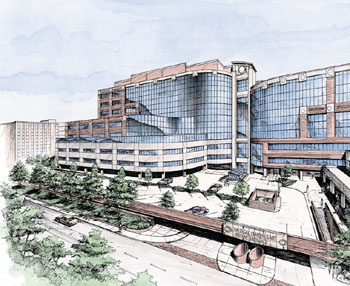
An artist’s rendering of the new building, facing 21st Avenue, adjacent to Medical Center East.
New building signals new era, confluence of care
The construction crane that towers over the parking deck on 21st Avenue will, over the next many months, gingerly lift tens of thousands of pounds of building material from one spot to another. But this looming creature is helping create more than an eight-story, 300,000-square-foot building. It’s facilitating the confluence of two identities—the former Bill Wilkerson Center and Vanderbilt’s Department of Otolaryngology into the Vanderbilt Bill Wilkerson Center for Otolaryngology and Communication Sciences.
"The union marks the beginning of a new era for the thousands of patients who come to Vanderbilt from all across America for quality care," says Dr. Harry R. Jacobson, vice chancellor for Health Affairs. "The Center will also provide convenience and support to our clinicians and researchers as all of the facility’s services will be housed under one roof."
It’s an idea that’s been 50 years in the making.
The Bill Wilkerson Center began taking shape, at least conceptually, in the 1940s when Nashville physician Dr. Wesley Wilkerson, a specialist in eye, ear, nose and throat medicine (now ear, nose and throat, or otolaryngology) began garnering community support for the only center in the Southeast United States that would study and treat hearing and speech disorders. World War II interrupted Wilkerson’s efforts, and it took the life of his only son, Bill, who died at the Battle of the Bulge when he was 19 years old.
In December, 1949, the center received its charter. Its board members met secretly and decided to name the facility after Bill, honoring both Dr. Wilkerson and his son. The first patients were seen in 1951 in the Bill Wilkerson Center’s first home, the old Sigma Chi fraternity house on Garland Avenue, now paved with asphalt for the University Club parking lot. In May of 1956, ground was broken on the current building, on the corner of 19th Avenue and Edgehill, a state-of-the-art building at the time, complete with its own fallout shelter. The Center was a block away from Vanderbilt University Medical Center but a world away from the cogs of a major medical center machine.
In the 1980s, Vanderbilt University Medical Center wanted to grow its otolaryngology program and recruited a young physican from Northwestern Medical School. He came here with visions of growth and excellence.
“I remember meeting Dr. Bess in the fall of 1985 when I came to interview at Vanderbilt, and thinking that it seemed a natural to get the two units closer together,” says Dr. Robert Ossoff, recalling his introduction to Fred Bess, Ph.D., who was director of the Bill Wilkerson Center.
In 1997, without the physical or fiscal resources to provide for necessary growth, Bill Wilkerson merged with its longtime neighbor, Vanderbilt University Medical Center, and was partnered with the department of Otolaryngology to form the Vanderbilt Bill Wilkerson Center for Otolaryngology and Communication Sciences. Ossoff was named the director and maintained his chairmanship of Otolaryngology; Bess continues as chairman of the department of Hearing and Speech Sciences and was named an associate director of the Center; and Dr. James Netterville, professor of Otolaryngology and director of the division of Head and Neck Surgery, was also appointed as an associate director of the Center.
But despite one name and one big organizational chart, the programs were fragmented geographically—housed in several buildings around campus.
The new building will, for the first time, house all of the Center’s programs. It will allow for growth the Bill Wilkerson Center sorely needs (the current building has only 600 square feet of dedicated education space, the new building will have 2,500 square feet of classrooms and an auditorium), will include a 1,000-square-foot anechoic chamber (the echo-free room used to study sound) and will help result in 35,000 to 40,000 more patient visits annually.
But perhaps the most synergy will be felt by researchers. Wesley Grantham, Ph.D., professor and director of research for the department of Hearing and Speech Sciences, will, for the first time, be “down the hall” from David Zealear, Ph.D., associate professor and director of research for the department of Otolaryngology.
“It will provide the opportunity to take basic information from animal models and get insight from people who know the mechanisms of speech and hearing,” Zealear says.
“The new building,” says Ossoff, “will be unlike anything in the country.”
When it is complete, in 2003, someone needing a cochlear implant can see a surgeon, audiologist, educator of the deaf, and speech-language pathologist in the same setting. And professional singers will be going through therapy under the same roof as a child with autism who is learning skills to communicate his basic wants.













